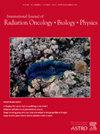探索他莫昔芬与放疗的联合作用(无论雌激素受体状态如何
IF 6.4
1区 医学
Q1 ONCOLOGY
International Journal of Radiation Oncology Biology Physics
Pub Date : 2024-10-01
DOI:10.1016/j.ijrobp.2024.07.068
引用次数: 0
摘要
目的/目标:他莫昔芬与雌激素受体的亲和力为纳摩尔级,常用于治疗ER+乳腺癌。近年来,人们逐渐发现了他莫昔芬在微摩尔浓度下的免疫调节作用。然而,它对抗肿瘤的免疫调节作用仍不明确。放疗(RT)仍然面临着原发性和继发性放射抗性,其部分原因是具有 M2 表型的肿瘤相关巨噬细胞(TAMs)的积累。调节免疫系统可能是克服放疗耐受的有效方法。迄今为止,他莫昔芬与 RT 联用的临床效果尚未明确。我们的研究旨在揭示他莫昔芬与 RT 的协同作用,为临床应用提供基础支持。材料/方法采用三种细胞系的皮下肿瘤模型来验证他莫昔芬与 RT 的协同作用。采用流式细胞术检测肿瘤中免疫细胞的浸润状态和功能。应用含有或不含他莫昔芬的肿瘤细胞条件培养基(CM)和放疗后CM(RTCM)刺激骨髓源性巨噬细胞(BMDMs)和RAW264.7转化为TAMs。结果在体内实验中,令人欣慰的是,放疗的抗肿瘤效果在 RT 和他莫昔芬联合组中得到了全面提升。相比之下,这种协同作用在免疫缺陷模型中消失了。据统计,联合治疗组的 CD8+ T 细胞和 CD86+ M1 TAMs 的浸润率高于单独治疗组,而 CD206+M2 TAMs 的浸润率没有明显变化。联合治疗组中 Gzmb+ 和 TNF-α+ TAM 的比例显著提高。此外,联合组中活化的 CD8+ T 细胞和细胞毒性 CD8+ T 细胞的比例都显著增加。在使用氯膦酸脂质体耗尽TAMs后,RT与他莫昔芬的协同作用消失了。在体外,M1 相关标志物的最高水平和 CD86+ 巨噬细胞的最高水平均出现在联合组中,这表明联合组在诱导 TAMs M1 极化方面具有极佳的效果。RNA 测序结果揭示了 RT 联合他莫昔芬通过激活 JNK/c-Jun 通路将 TAMs 极化为 M1 型的机制。总之,我们发现 RT 联合大剂量他莫昔芬能显著激活 JNK/c-Jun 通路,进而调节免疫微环境,最终在体内产生更强的抗肿瘤效应。免疫调节功能可能会为他莫昔芬的应用揭开新的篇章。本文章由计算机程序翻译,如有差异,请以英文原文为准。
Exploring the Combined Effects of Tamoxifen and Radiotherapy, Regardless of Estrogen Receptor Status
Purpose/Objective(s)
Tamoxifen has been commonly used for the treatment of ER+ breast cancer with nanomolar affinity for the estrogen receptor. In recent years, the immunomodulatory effects of tamoxifen at micromolar concentration have gradually been discovered. However, its immunomodulatory action on anti-tumor was still ambiguous. Radiotherapy (RT) still faces primary and secondary radiation resistance which partially originates from the accumulation of tumor-associated macrophages (TAMs) with the M2 phenotype. Regulating the immune system may be an effective way to overcome radiotherapy tolerance. To date, the clinical effect of combining tamoxifen with RT has not been clearly defined. Our study aimed to uncover the synergistic effect of tamoxifen with RT and provide basic support for clinical applications.
Materials/Methods
Subcutaneous tumor models with three cell lines were adopted for certificating the synergistic effect of tamoxifen with RT. The infiltration status and function of immune cells among tumors are detected by flow cytometry. The tumor cell conditioned medium (CM) and CM after radiotherapy (RTCM) with or without tamoxifen were applied for stimulating bone marrow-derived macrophages (BMDMs) and RAW264.7 to TAMs. We performed RNA sequencing to detect the mechanism of the synergistic effect and completed the validation.
Results
In vivo experiments, it was gratifying that the anti-tumor effect of radiotherapy was all boosted in the combination group of RT and tamoxifen. In comparison, the synergistic action disappeared in immunodeficiency models. The infiltration of CD8+ T cells and CD86+ M1 TAMs was statistically higher in the combination group than the alone treatment group, while the CD206+M2 TAMs did not vary obviously. The proportion of Gzmb+ and TNF-α+ TAMs dramatically improved in the combination group. Furthermore, the proportion of activated CD8+ T cells and cytotoxic CD8+ T cells both remarkably increased in the combination group. After depleting TAMs with clodronate liposomes, the synergistic effect of RT with tamoxifen vanished. In vitro, the highest level of M1-related markers and the highest level of CD86+ macrophages both appeared in the combination group demonstrating the excellent combination effect of inducing TAMs M1 polarization. The RNA sequencing results revealed the mechanism by which RT combined with tamoxifen polarized TAMs to M1-type by activating the JNK/c-Jun pathway. The addition of JNK-IN-8, an inhibitor of JNK, supports the pivotal role of the JNK/c-Jun pathway in the process of M1 polarization induced by tamoxifen combined with RT.
Conclusion
All in all, we found RT combined with high-dose tamoxifen could significantly activate the JNK/c-Jun pathway, and then modulate the immune microenvironment, finally resulting in a stronger antitumor effect in vivo. The immunomodulatory function may open a new chapter for the application of tamoxifen.
求助全文
通过发布文献求助,成功后即可免费获取论文全文。
去求助
来源期刊
CiteScore
11.00
自引率
7.10%
发文量
2538
审稿时长
6.6 weeks
期刊介绍:
International Journal of Radiation Oncology • Biology • Physics (IJROBP), known in the field as the Red Journal, publishes original laboratory and clinical investigations related to radiation oncology, radiation biology, medical physics, and both education and health policy as it relates to the field.
This journal has a particular interest in original contributions of the following types: prospective clinical trials, outcomes research, and large database interrogation. In addition, it seeks reports of high-impact innovations in single or combined modality treatment, tumor sensitization, normal tissue protection (including both precision avoidance and pharmacologic means), brachytherapy, particle irradiation, and cancer imaging. Technical advances related to dosimetry and conformal radiation treatment planning are of interest, as are basic science studies investigating tumor physiology and the molecular biology underlying cancer and normal tissue radiation response.

 求助内容:
求助内容: 应助结果提醒方式:
应助结果提醒方式:


